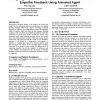1172 search results - page 31 / 235 » Who killed design |
IPM
2008
13 years 7 months ago
2008
by studying lawyers, analyse information-seeking at a high level of abstraction and are only likely to lead to broad-scoped design insights. We illustrate that one potentially usef...
CHI
2008
ACM
14 years 8 months ago
2008
ACM
Technology, it is argued, has the potential to improve everyone's life: from the workplace, to entertainment, to easing chores around the home. But what of people who have ne...
IPSN
2009
Springer
14 years 2 months ago
2009
Springer
Sensor network application experts such as biologists, geologists, and environmental engineers generally have little experience with, and little patience for, general-purpose and ...
PERSUASIVE
2009
Springer
14 years 2 months ago
2009
Springer
Experiencing emotional distress is the number one reason why people who are undergoing behaviour modification (e.g. quitting smoking, dieting) suffer from relapses. Providing emot...
CSCW
2006
ACM
14 years 1 months ago
2006
ACM
Task dependencies drive the need to coordinate work activities. We describe a technique for using automatically generated archival data to compute coordination requirements, i.e.,...


